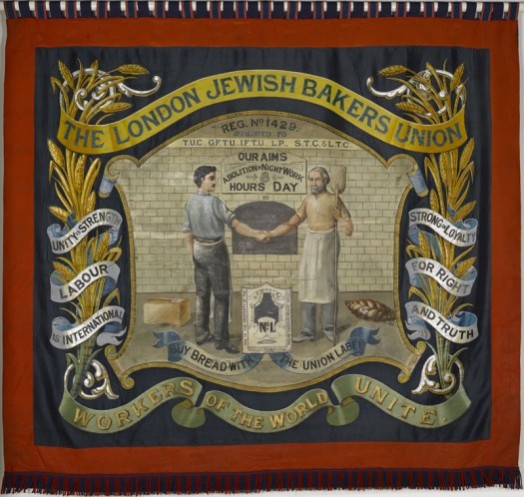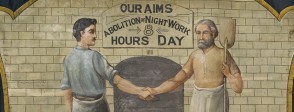
The banner
Banners were originally made to be displayed in the rooms where meetings of the early trade unions took place. After the legalisation of unions in 1825, banners were also carried or displayed to identify the unions on public occasions such as marches and demonstrations. This banner was made for the London Jewish Bakers’ Union. Like most union banners it displays symbols and slogans from the specific union as well as more general mottoes of the labour movement. Nowadays its demands seem quite modest - no night working and maximum eight hour days - but in this period, when labour laws were in their infancy, workers were sometimes forced to work very long shifts, even up to 27 hours at a time, and bakers in particular worked in terrible conditions. It also encourages consumers only to buy bread with a union label in order to support the fair treatment of workers. The reverse of the banner is in Yiddish, so it could be understood by members of the Jewish community in east London who could not yet read English.
Jewish immigration and unions
While there had been an official Jewish presence in Britain since the 1656, the late 1800s saw an increase in immigration by Jews escaping anti-semitic violence in Russia after the assassination of Tsar Alexander II in 1881. Jewish immigrants mainly settled in Leeds, Manchester and in the east end of London, particularly Spitalfields and Whitechapel. It is estimated that by 1919 about 150,000 Jews had immigrated to the UK. They formed tight-knit communities, continued religious and cultural traditions and established businesses which provided many opportunities for employment. These included bakeries supplying traditional breads. Government response to this wave of immigration was influenced by the media and by organisations such as the British Brothers League, a proto-fascist organisation, founded in East London, and in 1905 the Aliens Act was passed which controlled immigration to Britain for the first time.
Unions had been officially legalised in the UK in 1871. In the early days of legalisation, many individual unions, as well as the Trades Union Congress (TUC), had passed resolutions stating their opposition to immigration. They cited now familiar arguments about immigrants taking jobs, undercutting wages and taking over parts of cities. They also excluded immigrants from union membership on the grounds of them not speaking English. In light of this, and encouraged by the growth of socialism, particularly on the continent, the Jewish workforce began to unionise itself. The Jewish encyclopaedia of 1906 lists 39 Jewish unions set up in London between 1882 and 1902. The London Jewish Bakers’ Union was created in 1905 as the International Bakers’ Union - members came from Germany, Poland, Russia and elsewhere - and continued until 1970, the longest lived Jewish union. Influenced to some extent by the successes achieved by Jewish unions and seeking to dissociate themselves from the ideology of the xenophobic far right, the more left-wing unions eventually changed their official position to one that corresponded better with principles of international brotherhood, labour mobility and political asylum.
The General Strike
In the years from AD 1921 to 1925 labour relations deteriorated steadily as British industry experienced a slump, especially in the areas that depended on export. Britain’s return to the gold standard in 1925 depressed the economy even further and increased already worsening levels of unemployment. Coalmines had been nationalised during the First World War and miners had gained significant benefits in terms of pay, working hours and safety, but these were lost when the mines were handed back to private owners in 1921. The owners moved swiftly to cut wages and raise working hours in a bid to improve profits which had fallen due to increased competition from Germany, Japan and the USA. The TUC supported the miners’ unions in their continuing dispute with the owners and after the failure of negotiations called a general strike in May 1926.
The unions that participated in the strike were mainly in heavy industry and transport, so the London Jewish Bakers’ Union did not go out on strike. However, its secretary took unilateral action, shutting off the power to Kossof’s Bakery to prevent its operation. He was arrested and eventually deported back to Russia. The government feared that the strike represented the start of a communist revolution and used the media to try to stoke anti-union sentiment in the country, though the strikers retained some sympathy both among politicians and the general public. After nine days, the TUC called an end to the strike following the granting of a High Court injunction that undermined its legality. The injunction had been requested by the National Sailors’ and Firemen’s Union, which did not support the strike. The miners continued to strike alone for another six months but were eventually forced by hardship to go back to work with lower wages and longer hours. Sympathetic strikes were made illegal in the Trades Disputes Act of 1927.
More information
Information about the banner from the Jewish Museum
http://www.jewishmuseum.org.uk/objects-in-focus-bakers-banner
BBC article on banners of the labour movement
http://www.bbc.co.uk/history/british/empire_seapower/banners_01.shtml
Banners of the National Union of Rail, Maritime and Transport Workers
http://www.rmtbristol.org.uk/2007/04/historic_trade_union_banners_o.html
Article from the BBC on East End Jews
http://www.bbc.co.uk/legacies/immig_emig/england/london/article_2.shtml
Short article on immigration in the early 1900s
http://www.nationalarchives.gov.uk/pathways/census/events/britain4.htm
Article on Jewish trade unions in England and the USA from a 1906 encyclopedia
http://www.jewishencyclopedia.com/articles/14471-trade-unionism
History of Jewish presence in London from the 1650s
http://www.visitjewishlondon.com/uk-jewish-life/history
History of the Trades Unions from the National Archives
http://www.nationalarchives.gov.uk/cabinetpapers/alevelstudies/trade-union.htm?WT.ac=The%20Trade%20Union%20Movement
Information on the General Strike from the National Archives
http://www.nationalarchives.gov.uk/cabinetpapers/alevelstudies/the-general-strike.htm?WT.ac=The%20General%20Strike
Article and sources on the General Strike
http://spartacus-educational.com/TUgeneral.htm
More information
-
Information about the banner from the Jewish Museum
Source: jewishmuseum.org.uk
-
BBC article on banners of the labour movement
Source: bbc.co.uk
-
Banners of the National Union of Rail, Maritime and Transport Workers
Source: rmtbristol.org.uk
-
Article from the BBC on East End Jews
Source: bbc.co.uk
-
Short article on immigration in the early 1900s
Source: nationalarchives.gov.uk
-
Article on Jewish trade unions in England and the USA from a 1906 encyclopedia
Source: jewishencyclopedia.com
-
History of Jewish presence in London from the 1650s
Source: visitjewishlondon.com
-
History of the Trades Unions from the National Archives
Source: nationalarchives.gov.uk
-
Information on the General Strike from the National Archives
Source: nationalarchives.gov.uk
-
Article and sources on the General Strike
Source: spartacus-educational.com


